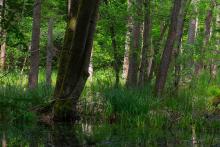
About Forest District
Forests belonging to the Babimost Forest District are located on the territory of two provinces and two different regions: Lubuski and Wielkopolska.

Forest resources
Na terenie Nadleśnictwa Babimost przeważają siedliska borowe z dominacją sosny.

Silviculture
Silviculture is the basis of human economic activity run in forests. A durable and sustainable management of forest areas is a forest management plan. The main tasks of foresters is to preserve and enrich the existing forest stands, called forest renewal. Another task is to create new forests which is commonly referred to as afforestation.

Forest protection
The knowledge of the processes occurring in natural environment as well as regular control of the forest standing allow foresters to make an early diagnosis of any threats that might have a negative impact on a forest condition. Every year they perform activities to ensure forest continuity and to increase its natural resistance to stress factors.
Nature preservation
Ochrona gatunkowa dotyczy najcenniejszych, unikatowych i rzadkich przedstawicieli fauny i flory. W Polsce ochroną ścisłą objętych jest 584 gatunków roślin, 90 gatunków grzybów i 732 gatunków zwierząt. 65 proc. gatunków dzikiej flory i fauny Polski to gatunki leśne.

Forest use
Utilization of forests means using its produce – timber, undergrowth, plants or their parts for the needs of pharmaceutical industry, cutting trees for Christmas trees, fossil fuel excavation and many more. Foresters make forest products available to the community, provided that the methods employed ensure forest continuity and sustainability.

Forest management
Forest management is the area of forestry governed by the State Forest Policy. The Forest Management Plan accepted by the Cabinet in 1997 states that the objective of the state is to achieve and maintain a multifunctional forest economy.

Hunting
Contemporary hunting comprises planned and coordinated activities aiming at rational management of the wild game living in forests.














